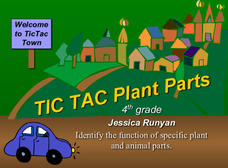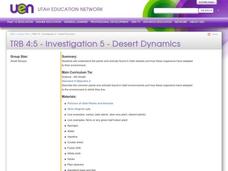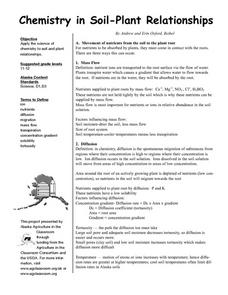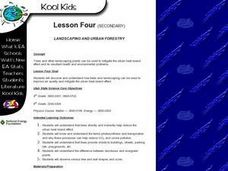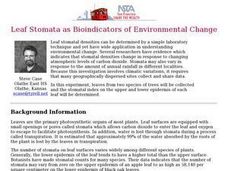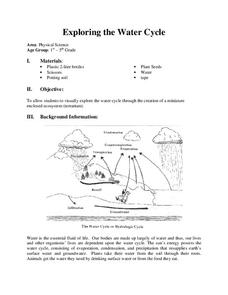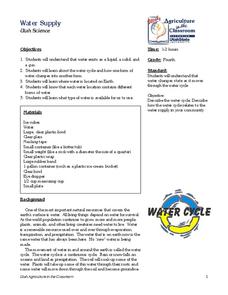Curated OER
'Round and 'Round it Goes!
Students discuss and interpret background knowledge on poster copy given on the water cycle. Students complete the included activity sheets using the poster as a reference in small groups. Students identify and name where water can be...
Curated OER
Aquatic Communities
Students watch a video about aquatic communities. They conduct an experiment that shows how movement of rivers change the landscape. They compare fresh and salt water communities and its wildlife.
Curated OER
PLANT PARTS WE EAT
Students identify an assortment of vegetables and learn how to locate the parts humans use for food. Students identify the plant parts we eat. Students color the pictures on their worksheets as provided. Students match the plants to the...
Curated OER
Tic Tac Plant Parts
This plant biology PowerPoint introduces plant parts and their functions. This PowerPoint allows students to identify each plant part on a diagram, along with its' function. The slides contain a clear explanation of how each plant part...
Curated OER
Leaves
In this biology worksheet, students write identify the different parts of a leaf shown in 5 different diagrams. They also complete 12 short answer questions after reading the information about leaves.
Curated OER
How Does a Green Plant Grow?
Students examine how a seed grows, and design an experiment to explore this concept. They make predictions, conduct the experiment, record the results, and interpret the results.
Curated OER
Desert Dynamics
Learners investigate the plants and animals found in Utah deserts and how these organisms have adapted to their environment. They brainstorm ways that desert plants are different from or similar to wetland plants.
Curated OER
Chemistry in Soil-Plant Relationship
Students apply the science of chemistry to soil and plant relationships. They define diffusion and indicate for which of these nutrient(s) would you expect diffusion to be the most important for movement to the plant root? Pupils...
Curated OER
The Hydrologic (Water) Cycle
Learners construct a model of the hydrologic cycle, and observe that water is an element of a cycle in the natural environment. They explain how the hydrologic cycle works and why it is important, and compare the hydrologic cycle to...
Curated OER
Weather Challenge
For this identifying the weather terms activity, students read phrases about the weather and choose the term being described. Students choose 11 multiple choice answers.
National Weather Service
The Water Cycle
Looking for a full-color, labeled water cycle diagram? You found one! From evaporation to precipitation to plant uptake and everything in between, it's all here and beautifully illustrated.
Forest Foundation
Forest Watersheds
Where does the water we use come from? To understand the concept of a watershed, class members study the water cycle and then engage in an activity that simulates a watershed.
Biology Junction
Water Properties and More
Did you know many insects use cohesion or surface tension to walk on water? Using a presentation, scholars learn the more important properties of water. It extends into the concepts of solutions, suspensions, pH, and more.
Curated OER
Water Cycle Drama
Students explore the water cycle. In groups, students choose a card and then pantomime the picture depicted on the card. Other group members guess the name of the cycle being performed. As a class, students share the numerous ways each...
Curated OER
Biosphere
There is so much to learn about the different cycles, processes, and parts of the biosphere. Using a pretest as a formative assessment to see what your budding ecologists already know is a great way to figure out which important areas...
Curated OER
Biochemical Cycles
When learning about several different processes at a time, it can be difficult to differentiate between them. In the resource found here, you can see what your kids know about some of Earth's systems including the carbon, hydrologic,...
Curated OER
Landscaping And Urban Forestry - Lesson 4 (Grades 8-9)
Students discuss reasons to plant trees and the best locations for cooling. They study two homes and identify types and locations of trees and determine the placement of the central air conditioners. The class plans a landscape design...
Curated OER
Leaf Stomata as Bioindicators of Environmental Change
Students, in this experiment, collect leaves from two species of trees and the stomatal index on the upper and lower epidermis of each leaf be determined.
Curated OER
Leaf Stomata as Bioindicators of Environmental Change
High schoolers perform an experiment to determine the stomaltal index on the upper and lower epidermis of two species of leaves. Stomatal densities change in response to changing atmospheric levels of carbon dioxide and to annual rainfall.
Curated OER
Clouds
In this weather worksheet, students read a detailed information sheet about different kinds of clouds and what weather they bring. Students answer 12 questions
Curated OER
Exploring the Water Cycle
Students investigate the water cycle. In this water cycle lesson, students create an ecosystem within a 2-liter bottle. Students record scientific observations as they observe the water cycle within their ecosystem.
Curated OER
Ecology
In this ecology instructional activity students complete a crossword puzzle that incorporates all of the ecological vocabulary in the word puzzle.
Curated OER
Germination Inhibitors
In germination experiment learning exercise, students conduct the following lab activity. Kids determine the effects of another tomato on germinating seeds. Students answer the following questions to analyze their experiment.
Curated OER
Water Supply
Fourth graders complete three activities. For this water supply lesson, 4th graders learn that water can exist in different forms and watch a demonstration of each form. Students explore the water cycle and make a water cycle using the...



